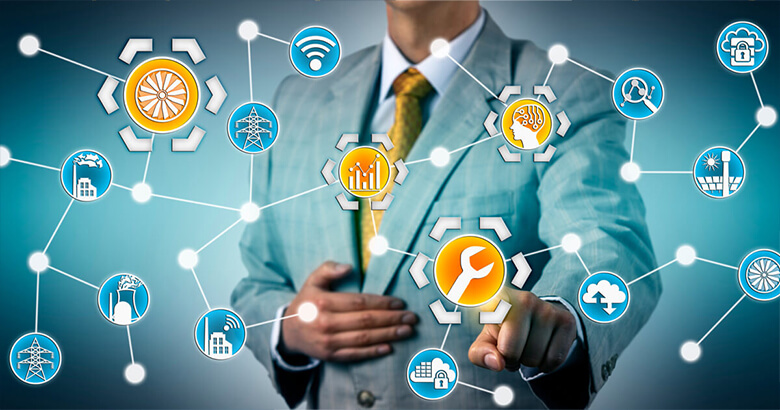Smart Services – from passive to active (I)IoT applications

IoT applications have so far mainly been used in connection with networking and analysis of field and operational data for the purpose of more ‘passive’ monitoring. The integration of data-driven smart services into already digitalized operational processes has great potential to create direct added value through ‘active’ decision support and control.
What are Smart Services?
Due to the availability of large amounts of data and the possibility to use it for specific purposes, such as the analysis or improvement of certain processes, digital (smart) services can be offered via the Internet. Such digital services are known from online shops, for example, when personalised recommendations or individualised advertising banners are displayed based on the available data.
The German National Academy of Science and Engineering acatech defines Smart Services as ‘packages of products, services and features individually configured via the Internet, tailored to the preferences of private and commercial users in a needs-based and situation-specific ‘as a service’ manner. Digital platforms play a central role: This is where products and services are mapped virtually, combined, enhanced with additional digital services and offered as Smart Services’.[1]
Transferred to industrial applications, these services extend or improve existing functions for product services. They can thus be used as a basis for decisions on optimising, controlling or adapting individual processes (at customers).
 Smart Services create direct added value
Smart Services create direct added valueSmart Services pose major challenges for IT
Internally, IT is required to provide new functions that meet the current requirements of digitalization. This already starts with new systems that enable agile transparent work in the form of enterprise social networks. In the future, this ‘agility’ and ‘transparency’ will also require access to data from other systems and applications involved, right down to resources and ecosystems. This requires a general strengthening of the IT infrastructure, so that both large amounts of data from different data sources can be processed, suitable data analyses can be carried out and all data and information can be made available to all departments in a context-specific manner.
Without end-to-end data and process integration mechanisms, the development and deployment of smart services is difficult to achieve.
The cross-enterprise provision of expertise on data-driven services poses an even greater challenge, particularly in terms of securing data sovereignty on the one hand and interoperability on the other. Here, ways are sought for a suitable depth of representation and for standards as to how this can be guaranteed, at least between companies and for individual sectors, without endangering the core competence of the company which is worth protecting and vital to its existence.
For many companies, offering digital services as a business model to the outside world is emerging as a promising way of retaining customers. This can be done via APIs (Application Programming Interfaces), for example, but this requires professional API management to control access and use of the interfaces. The consumption of digital services can also be managed in this way, which is important from the user’s point of view with regard to further internal integration. These type of Smart Services offer interesting opportunities for companies in the B2B sector, both from the customer and the supplier perspective.
 For Smart Services the IT infrastructure must be built up
For Smart Services the IT infrastructure must be built upImplementation of Smart Service projects still under construction
Overall, the structures are not yet sufficiently mature for broad B2B use. Although most companies are in the process of setting up the infrastructure and introducing new systems such as IoT platforms, the interaction of these, for example with business applications, is only just being implemented. According to an IDC study on the status of industrial IoT in Germany, of the IT and technical decision-makers from 258 organisations, around 42% have already implemented IoT projects or are in a concrete pilot phase, and a further 47% are planning and evaluating them. Here the focus is still primarily on classic, internal optimisation.
For this reason, the available services today are rather limited to aspects of monitoring with a reduced view of available data. But, as the study also makes clear, many are already thinking one step ahead and also want to attract new customers (27%) and improve the customer experience with new, data-based services (26%).
New B2B-integrated Smart Services
Especially for export-oriented German companies, smart services offer a high economic value to deepen customer relations and to transfer the accustomed quality standards of tangible goods to the digital world. The Federal Government continues to see a need to provide even more targeted support for research and development in the area of smart services in the B2B sector, despite the large funding programmes that have already been implemented, such as the ‘Smart Service World’, which has been in place since 2013. For example, the BMBF recently placed a special focus on ‘Internet-based services for complex products, production processes and plants (smart services)’ in its specialist programme ‘Innovations for the production, services and work of tomorrow’. The SEAMLESS joint project was launched in February 2020 with the participation of SEEBURGER. This will explore and develop new ways of seamlessly providing SME-friendly, Internet and simulation-based after-sales services. These are to be made available later in service units that can be called up, used and paid for separately via a platform. Machine manufacturers and users should thus be enabled to use simulations that meet their needs without having to acquire expertise themselves. Using the technology of augmented reality, data is fed to the service staff in real time via corresponding, specially prepared content, in order to create measurable added value in the processes of operational optimization, maintenance and conversion. Many of these initiatives and results will help to spark the still rather restrained momentum in the use of new active (I)IoT applications.
[1] https://en.acatech.de/project/digitale-serviceplattformen-erfolgskriterien-fur-die-smart-service-welt/
Source: https://blog.seeburger.com/smart-services-from-passive-to-active-iiot-applications/
 industry-trend6.com
industry-trend6.com
